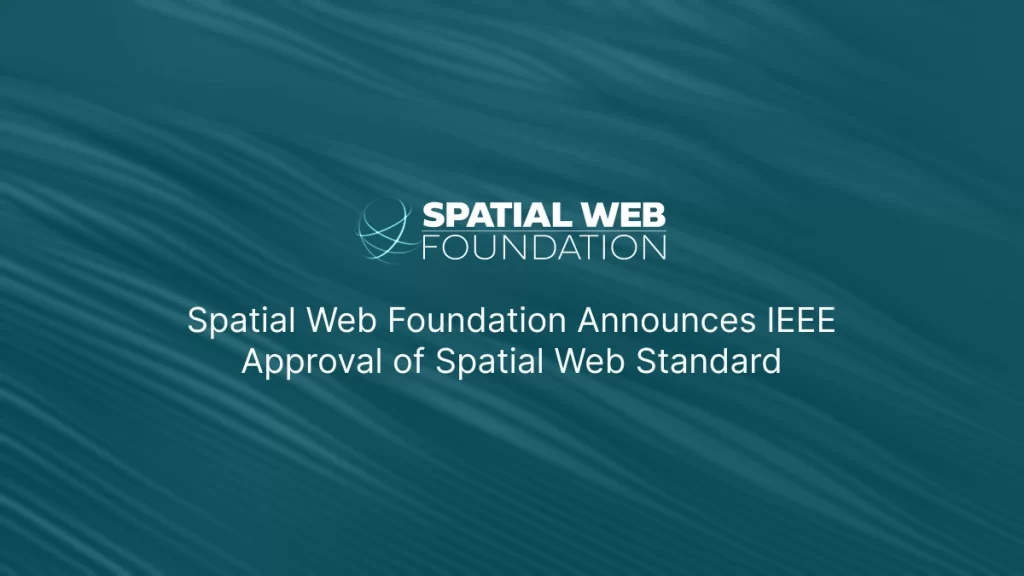Los Angeles, CA – 03 June 2025 – (GLOBE NEWSWIRE) – The Spatial Web Foundation (SWF) proudly announces that The Institute of Electrical and Electronics Engineers Standards Association (IEEE SA) has officially ratified the IEEE 2874 Spatial Web Standard: the Hyperspace Modeling Language (HSML) and the Hyperspace Transaction Protocol (HSTP).
This groundbreaking standard establishes the technical foundation for a secure, interoperable, and intelligent Spatial Web, enabling collaboration between AI agents, IoT devices, robotics systems, and digital infrastructure across real-world environments.
The Spatial Web Protocol, Architecture, and Governance Standard was developed over a five-year period by a diverse IEEE SA Working Group from industry, government, academia, and civil society. The Standards were developed within the IEEE Artificial Intelligence Standards Committee, under the auspices of the IEEE Computer Society, the largest global community of computer scientists and engineers.
The first of its kind, the IEEE Spatial Web Standard represents not only a technical protocol, but a global framework for how intelligent systems interact with both the physical and social worlds. By encoding semantic meaning, spatial context, and temporal logic, these standards enable the digital representation of people, places, objects, and processes in a manner that machines can understand and act upon—while ensuring alignment with human-designed systems of law, governance, and coordination.
Just as past IEEE standards laid the foundation for technologies like Wi-Fi® and Bluetooth®, the Spatial Web Standard (HSML and HSTP) provides a common language that manufacturers, developers, and engineers can rely on to build interoperable, compliant systems, reducing friction, accelerating deployment, and lowering integration costs. At the same time, it provides governments, regulators, and institutions with a technical foundation for developing policies, laws, and safeguards that help ensure these systems operate safely and ethically in the real world.
By defining the methods and the rules for intelligent agents to interact with both digital systems and physical environments, the IEEE 2874 unlocks new possibilities for automation, coordination, and control in sectors such as smart cities, logistics, manufacturing, defense, healthcare, aerospace, and virtual worlds.
Key benefits include:
- Increased interoperability across hardware, software, and environments
- Improved explainability and transparency in autonomous systems
- Spatial encoding of laws and permissions to improve governance and regulatory compliance
- Reduced integration costs through standardized protocols and metadata structures
- Accelerated development of AI and robotic systems with plug-and-play intelligence and data permissions
“The Spatial Web is an ecosystem of intelligent agents coordinating activities toward shared goals,” said George Percivall, Vice-Chair of the IEEE 2874 Working Group. “Using space as the organizing principle, the standard is a foundational leap toward scalable, collective intelligence.”
The IEEE standards can play a crucial role, not only in ensuring interoperability but also in defining the rules, norms, and governance of AI, IoT, and robotic systems.
“These standards provide the common ground for intelligent systems to more safely be released and utilized in the physical and social world,” said John C. Havens, former Executive Director of the IEEE Global Initiative on the Ethics of Autonomous and Intelligent Systems. “They represent a key milestone in helping to ensure that as our systems become more advanced and integrated with society, they also become more aligned with societal values.”
“Having participated in the IEEE-SA P2874 Spatial Web Protocol, Architecture and Governance Working Group, I am glad to see the initiative become standard,” said Mike Warner, Senior Standards Specialist at the Treasury’s Office of Financial Research and former Senior Strategist at the Federal Reserve Bank of San Francisco. “I’ve had the opportunity to contribute on many standards, and I think that HSML and HSTP have important potential roles in the emerging era of computing.”
From Earth to space, intelligent systems need a shared language to coordinate action safely.
“The Spatial Web standards offer the blueprint for harmonizing data across digital twins and enabling interoperability between AI agents,” said Dr. Ed Chow, distinguished engineer at NASA’s Jet Propulsion Laboratory.
“The ratification of the Spatial Web standards marks a turning point—akin to the launch of TCP/IP for the internet,” said Bastiaan den Braber, Director of Operations at the Spatial Web Foundation. “The standards lay the groundwork for a network that is not just informational, but spatial and intelligent—bridging the gap between the physical and digital worlds. This is how we prepare for, build, and benefit from the next era of the Web.”
About Spatial Web Foundation
The Spatial Web Foundation is dedicated to the development and implementation of socio-technical standards that will provide a safe and secure and interoperable foundation for the Spatial Web. These standards ensure that exponential technologies are not only technically robust but also socially beneficial, safe, compliant with existing laws, and in alignment with societal norms and values. SWF is a community of developers, creators, scientists, and innovators with a shared mission to enable a hyper-connected, contextually aware, ethically-aligned network of humans, machines, and artificial intelligence.
On behalf of the Company
Press Inquiries: https://spatialwebfoundation.org/swf/contact/
You can find more information at: https://spatialwebfoundation.org/ and https://sagroups.ieee.org/2874/

